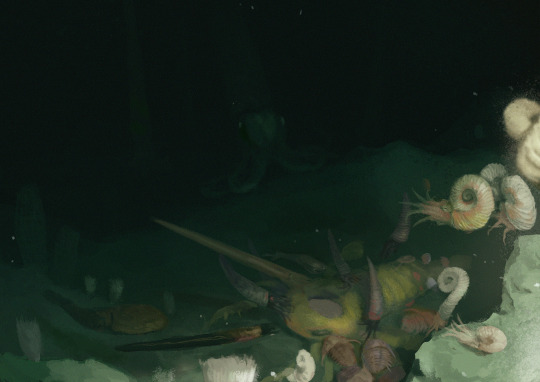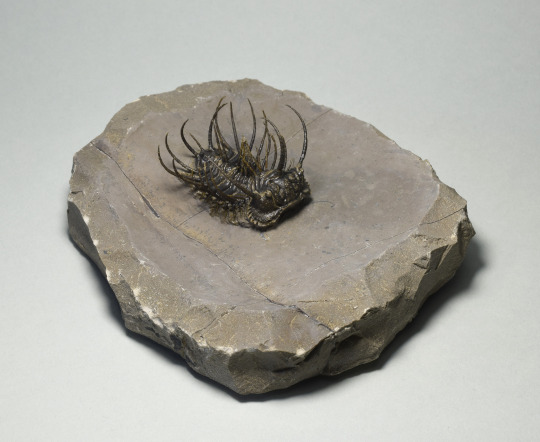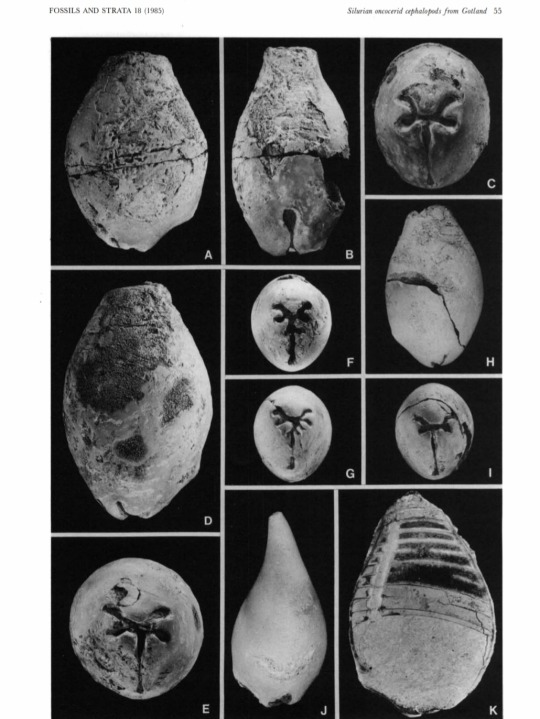#palaeozoic
Explore tagged Tumblr posts
Text

POV: you went diving at night and spotted Ordovician nautiloids feasting on a eurypterid carcass, after a while the commotion has attracted the giants, Endoceratids slowly creeping into view
#illustration#art#paleo art#paleoart#palaeoblr#ordovician#palaeontology#nautilus#nautiloid#cephalopod#eurypterid#orthocone#trilobite#palaeozoic#endoceras#endoceratid
9K notes
·
View notes
Text

Thelodus illustration I found. One of the first fish and so silly shaped too
7 notes
·
View notes
Text
🌿PALAEO CLUB🌿
I am once again looking for people who want to join a palaeontology discord server.
If you're interested in dinosaurs, prehistorical animals or any other similar types of things... Then you've come to the right place!
Send over an ask and I'll dm you the join link to the server. (I do this to keep trolls out)

#dinosaur#paleoart#paleontology#palaeoart#palaeozoic#palaeoblr#dinoart#dinosaurs#discord server#science
2 notes
·
View notes
Text

Trilobites were marine arthropods that inhabited the oceans from the Cambrian (521 Ma) to the Permian (251 Ma). They display beautiful calcitic exoskeletons that are often ornamented of genal, thoracic and pygidial spines. Trilobites were also the first group of animals to develop complex eyes that are sometimes incredibly well-preserved. The fine trilobites here offered for sale were carefully selected by us. Our criteria include rarity, visual appeal, preservation, quality of preparation and authenticity. Descriptions mention restorations if present.
0 notes
Text
In regard to the Invertebrata, Barrande, and a higher authority could not be named, asserts that he is every day taught that the palaeozoic animals, though belonging to the same orders, families, or genera with those living at the present day, were not at this early epoch limited in such distinct groups as they are now.
"On the Origin of Species by Means of Natural Selection, or the Preservation of Favoured Races in the Struggle for Life" - Charles Darwin
#book quote#the origin of species#charles darwin#nonfiction#invertebrates#joachim barrande#expert#paleozoic#palaeozoic#order#family#genus#genera#diversity
0 notes
Text
youtube
The Ocean Collective - Phanerozoic I: Palaeozoic - Silurian: Age of Sea Scorpions
#the ocean collective#phanerozoic i: palaeozoic#silurian: age of sea scorpions#with gratitude and certainty that the glaciers will retreat#yield to warm and shallow seas or maybe not#i am super fucked and all i really want is to sleep now#Youtube
6 notes
·
View notes
Text
the debate of "do you declare a box that has vinyls and a few art prints under tariff code 8523.80 or do you need to declare the art separately even though there is no listed material value to the prints and there is also no duty fees for those"
3 notes
·
View notes
Text
youtube
0 notes
Text
New song in likes.
1 note
·
View note
Photo

200 million ya, Ireland and Scotland were a part of the same range as the Appalachian mountains, where, funny enough, the majority of Scottish and Irish emigrants settled in America.
from Evolution of the Rheic Ocean via u/MUNKIESS
The Rheic Ocean, which separated Laurussia from Gondwana following the closure of Iapetus, is arguably the most important ocean of the Palaeozoic. Its suture extends from Mexico to Turkey and its closure produced the climactic Variscan–Alleghanian–Ouachita orogeny that assembled the supercontinent, Pangaea.Following protracted Cambrian rifting that represented a continuum from Neoproterozoic orogenic processes, the Rheic Ocean opened in the Early Ordovician with the separation of several Neoproterozoic arc terranes from the continental margin of northern Gondwana.
Separation occurred along the line of a former Neoproterozoic suture following the onset of subduction in the outboard Iapetus Ocean. The timing of rift–drift transition and drive for subsequent spreading was likely governed by slab pull, accounting for the rapid rate (8–10 cm/yr) at which the Rheic Ocean widened.During the Ordovician, the ocean broadened at the expense of Iapetus and attained its greatest width (~ 4000 km) in the Silurian, by which time Baltica had sutured to Laurentia and the Neoproterozoic arc terranes had accreted to Laurussia, closing Iapetus in the process.
Closure of the Rheic Ocean began in the Devonian and was facilitated by northward subduction beneath southern Baltica and southward subduction beneath northwest Gondwana. Closure was largely complete by the Mississippian as Gondwana and Laurussia sutured to build Pangaea, North Africa colliding with southern Europe to create the Variscan orogen in the Devonian–Carboniferous, and West Africa and South America suturing to North America to form the Alleghanian and Ouachita orogens, respectively, during the Carboniferous–Permian.The Rheic Ocean consequently plays a dominant role in the basement geology of southern Europe, in the Appalachian–Ouachita orogeny of North America, and in the Palaeozoic sedimentary, structural and tectonothermal record from Middle America to the Middle East. With its closure, the ocean brought about the assembly of Pangaea and brought the Palaeozoic Era to an end.
2K notes
·
View notes
Text

This floating alien egg is Octameroceras, they're part of a group of cephalopods called Oncocerids which diverged earlier than the nautiloids and ammonites.
As they reach maturity, their shell opening, the aperture closes in on their face creating these Giger-esque shapes, and we can only speculate what bizarre mangled forms the creature peeping through that opening would have.

[image credit: Stridsberg, S. 1 985 05 09: Silurian oncocerid cephalopods from Gotland. Fossils and Strata, N o. 1 8, pp. 1-65. Oslo ISSN 0300- 9491. ISBN 82- 00- 07575-3.]
#art#paleoart#paleo art#palaeoblr#paleontology#cephalopod#Oncocerid#Oncocerida#octameroceras#Palaeozoic#blender3d#blender#3d model#animation 3d#animation#sea creatures
2K notes
·
View notes
Text

Gaiasia jennyae was a tetrapodomorph – an amphibian-like relative of early tetrapods – that lived about 280 million years ago during the early Permian in what is now Namibia.
Although it's only known from incomplete skull and vertebral column material it probably looked quite similar to the colosteids, a closely-related group of tetrapodomorphs with elongated bodies and small limbs. If it had the same sort of body proportions as these relatives it would have been huge, the largest known stem-tetrapod at potentially around 4m long (~13').
It had a wide flat head with a short boxy snout, and large interlocking fangs on the roof of its mouth and at the front of its lower jaw. It would have been fully aquatic and probably not a particularly fast swimmer, instead likely being an ambush predator using suction from rapidly opening its jaws to pull prey into its mouth before clamping down with its fangs.
It's also notable for living considerably later than most other stem-tetrapods, and in an unexpected part of the world. While its close relatives are all known from the tropics of the Carboniferous, Gaiasia was in a location that was much closer to the South Pole during the early Permian (~55° S), inhabiting an immense freshwater lake in a rift valley with a cold-temperate climate.
Its presence in this habitat may suggest that other stem-tetrapod lineages survived and thrived in high latitudes for much longer than previously thought, while the true tetrapods were all diversifying nearer the equator – or it might represent a Paleozoic equivalent of Koolasuchus, an isolated straggler lurking in a cold refugium.
———
NixIllustration.com | Tumblr | Patreon
References:
Marsicano, Claudia A., et al. "Giant stem tetrapod was apex predator in Gondwanan late Palaeozoic ice age." Nature (2024): 1-6. https://www.nature.com/articles/s41586-024-07572-0
Naish, Darren. "'The whole front of the mouth is just giant teeth.' Prehistoric swamp monster with toilet-seat head dug up in Namibia." Discover Wildlife, 3 Jul. 2024, https://www.discoverwildlife.com/animal-facts/gaiasia-jennyae
Stollhofen, Harald, et al. "AAPG Studies in Geology# 46, Chapter 6: The Gai-As Lake System, Northern Namibia and Brazil." (2000): 87-108. https://www.researchgate.net/publication/255979661_The_Gai-As_Lake_System_Northern_Namibia_and_Brazil
Wikipedia contributors. “Gai-As Formation.” Wikipedia, 8 Jul. 2024, https://en.wikipedia.org/wiki/Gai-As_Formation
Wikipedia contributors. “Gaiasia.” Wikipedia, 8 Jul. 2024, https://en.wikipedia.org/wiki/Gaiasia
244 notes
·
View notes
Text

Oroperipatus tiputini: A new species of Velvet Worm from the Ecuadorian Amazon.
Velvet Worms, Onychophora, are a unique group of elongate, soft bodied, many legged Animals, given phylum status and considered to be among the closest living relatives to the Arthropods. They are currently the only known phylum of Animals known entirely from terrestrial species, both living and fossil, although they may be related to the Lobopodans, an entirely marine group known only from Early Palaeozoic fossils. The 230 living Velvet Worm species are divided into two groups, the Peripatidae, found in the tropics of Central and South America, the Antilles Islands, Gabon, India, and Southeast Asia, and the Peripatopsidae, found in Chile, South Africa, Papua New Guinea, Australia, and New Zealand. All South American members of the Peripatidae are placed within a single clade, the Neopatida, which is further divided into two lineages, the 'Andean' genus Oroperipatus, and the 'Caribbean' lineage, comprising all other genera. Read the paper: (https://zse.pensoft.net/article/117952/) The new species is described from five male, three female, and three juvenile specimens collected in the vacinity of the Tiputini Biodiversity Station of the Universidad San Francisco de Quito in Orellana Province, Ecuador, between 2001 and 2023, as well as one youngling, which one of the female specimens gave birth to in captivity. The new species is named Oroperipatus tiputini, in reference to the location where it was discovered. Adult female specimens of Oroperipatus tiputini very between 46 and 65.3 mm in length, while the adult males are smaller at 22.7 to 39.8 mm. Females have between 37 and 40 pairs of legs, while the males have between 34 and 37, although one male specimen had a different number of legs on each side, with 35 legs on the right and 36 legs on the left. The species shows considable colour variation, with one adult male being a light brown colour with a faint rhomboid pattern, two adult males and one adult female being brown with orange diamonds, and another female (the one which produced a youngling) being a plain dark orange colour. The youngling itself was yellowish with a diamond pattern. All specimens were darked on their heads and antenae, had orange or brown legs, and a distinctive white band on the head. Most specimens of Oroperipatus tiputini were found on small herbaceous Plants within old growth, closed canopy upland forests around the Tiputini Biodiversity Station. Other specimens were found in leaf litter, or on the butress roots of trees to a height of about 70 cm above the ground. One specimen was found in a Bromiliad. The Worms were more active at night.
IMAGE: Colour variation in the life of Oroperipatus tiputini. (A) Adult male paratype, ZSFQ-i8270; (B) adult male paratype, ZSFQ-i5151; (C) adult female holotype, ZSFQ-i8248, and youngling paratype, ZSFQ-17794, a few days after being born. All photographs were taken at the Tiputini Biodiversity Station. Photographs by Pedro Peñaherrera (A), (C) and Diego Cisneros-Heredia (B).
299 notes
·
View notes
Text
back in the Palaeozoic, arthropods were bigger because the high oxygen levels in the atmosphere could support their weird shitty breathing systems. this is known. less well known is that a larger arthropod could support a more complex nervous system, could support more intelligence. Arthropleura had a tool-using civilisation in the upper Carboniferous, of which little remains in the fossil record. why? at that time, lignin was a novel development in woody trees, and since it could not yet rot — the enzymes would not be invented for another few million years — wood was the ideal material for making tools. the myriapods' material culture is sandwiched among the coal beds, compacted and carbonised beyond intelligibility. the coal beds and the Carboniferous came to an end when bacteria and fungi evolved to degrade wood, and this crisis heralded the downfall of the Arthropleura as the rot spread through the damp of their waterside cities. their foundational assumption was that wood was eternal. they struggled on into the lower Permian, never returning to their previous heights, and were eventually outcompeted by early tetrapods.
67 notes
·
View notes
Text
0 notes
Text
Even if the few fossil species which are common to the Old and New Worlds be kept wholly out of view, the general parallelism in the successive forms of life, in the stages of the widely separated palaeozoic and tertiary periods, would still be manifest, and the several formations could be easily correlated.
"On the Origin of Species by Means of Natural Selection, or the Preservation of Favoured Races in the Struggle for Life" - Charles Darwin
#book quote#the origin of species#charles darwin#nonfiction#fossils#old world#new world#paleozoic#tertiary#palaeozoic#evolution#natural selection
0 notes